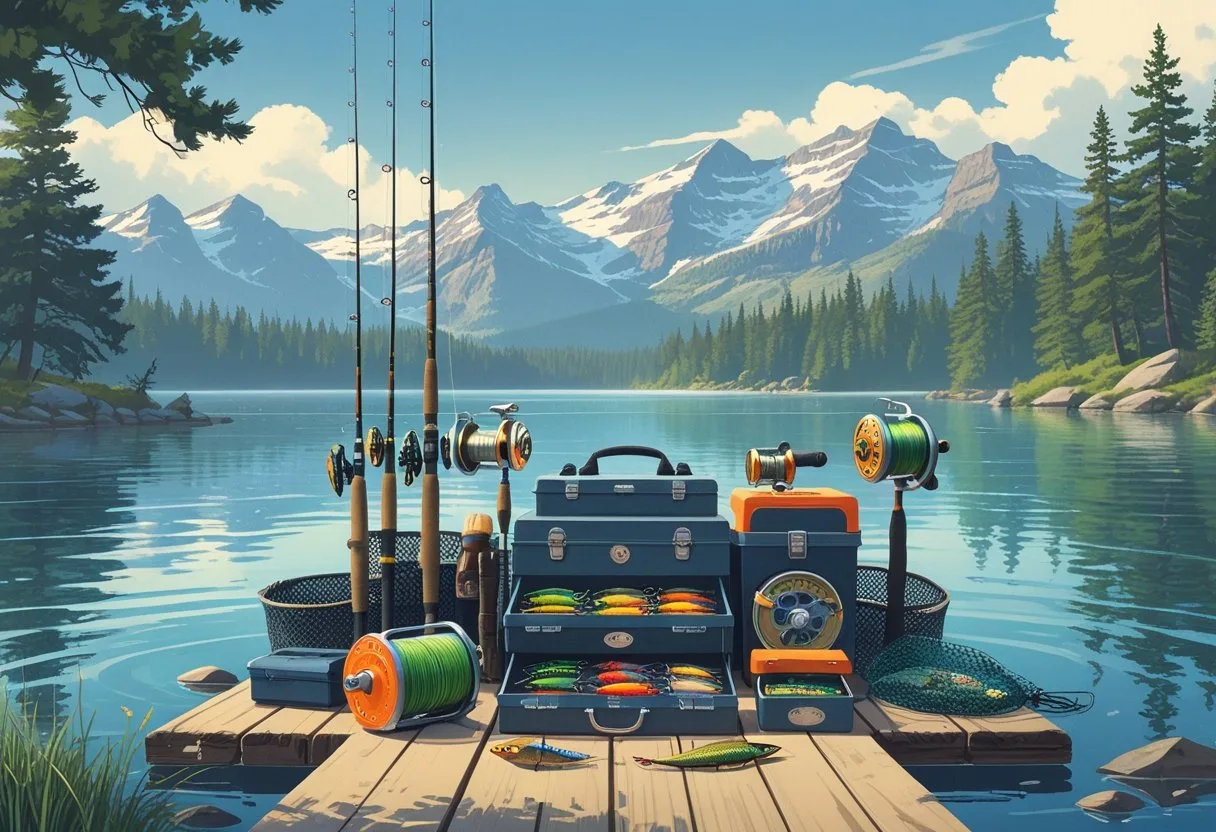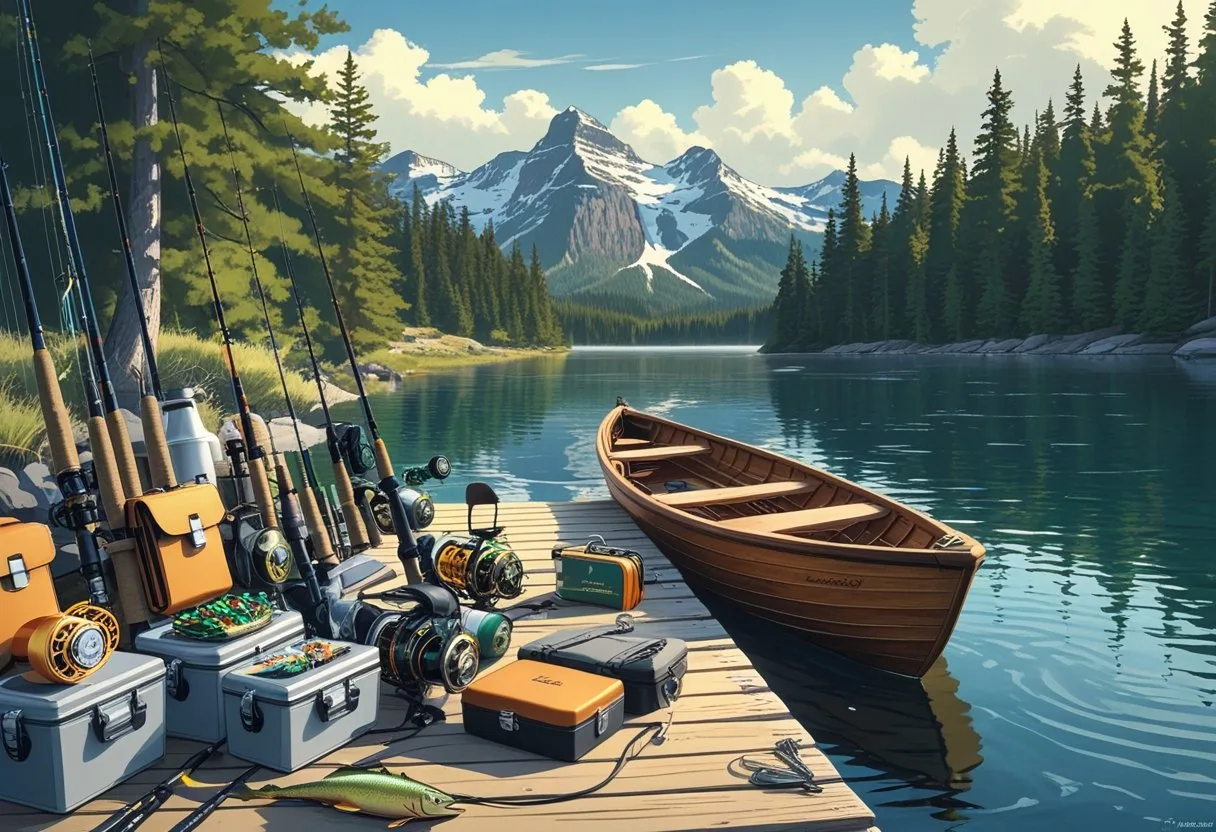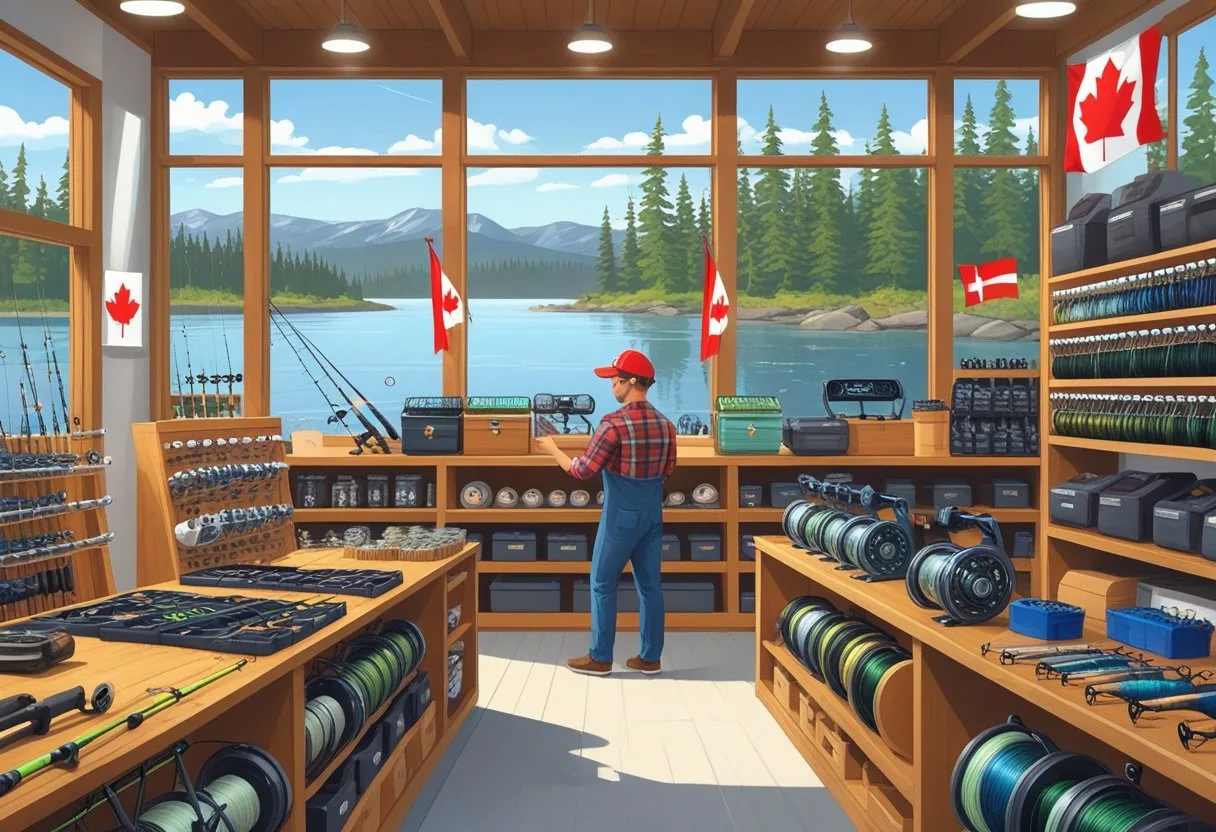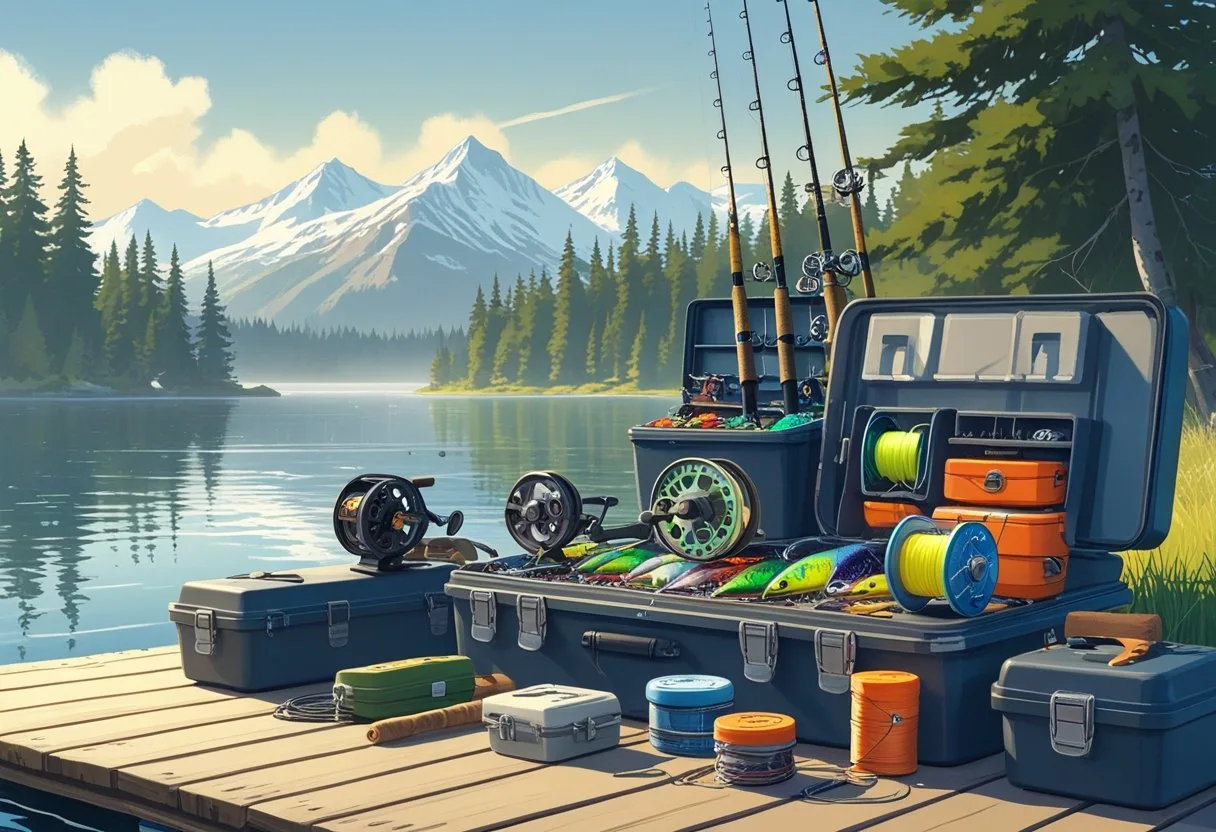Canada offers some of the world’s best fishing opportunities, from Atlantic salmon to Pacific halibut. The country has many specialized fishing stores and retailers that offer gear designed for Canadian waters and fishing conditions. Fishing Gear Canada
Whether you plan to fish in the Great Lakes, coastal waters, or northern wilderness areas, the right equipment makes a big difference.

Canadian anglers need gear that can handle everything from ice fishing in winter to deep-sea fishing in summer. The fishing gear market includes both large retailers and specialized local shops that understand regional needs.
Many stores offer both online shopping and physical locations across the country.
This guide covers the different types of fishing gear available, specialized equipment for Canadian waters, and where to find quality gear.
Types of Fishing Gear Available in Canada
Anglers have access to a wide range of Fishing Gear Canada for different water conditions and fish species. Basic rods and reels, specialized tackle, and protective gear all play a role in fishing success.
Rods and Reels
Choose your rod based on fishing style and target species. Spinning rods are great for beginners because they are easy to use and handle most situations.
These rods pair well with spinning reels for versatile fishing.
Casting rods handle heavier lures and lines better than spinning rods. They give experienced anglers more control when targeting larger fish like northern pike or muskies.
For reels, three main types are common. Spinning reels offer versatility and suit all skill levels. Baitcasting reels give precision casting but take practice to master.
Spincast reels work well for kids and beginners.
| Rod Type | Best For | Skill Level |
|---|---|---|
| Spinning | Most situations | All levels |
| Casting | Heavy lures, big fish | Intermediate+ |
| Fly | Trout, salmon | All levels |
Fly rods are essential for trout and salmon fishing in Canada. These rods need matching fly reels and specific techniques.
Tackle, Lures, and Bait
Canadian waters require different lures for different fish. Hard bait lures like crankbaits work well for walleye and bass.
Jerkbaits imitate injured baitfish and attract pike. Outdoor Life provides more information on top lures for various species.
Soft plastic lures offer versatility. Plastic worms work for almost any fish species when rigged properly.
Swimbaits look like real baitfish and attract larger predators. Spinnerbaits excel in murky water conditions common in many Canadian lakes.
The spinning blades create vibration that fish can sense even when visibility is low. For live bait fishing, use larger hooks with big baits like shiners, and smaller hooks with worms or leeches.
Jigs are effective year-round and catch everything from perch to lake trout when matched with the right trailer.
Fishing Line and Accessories – Fishing Gear Canada
Three main line types serve different purposes. Monofilament line stretches when fish strike, helping prevent break-offs. It also costs less than other options.
Fluorocarbon line is almost invisible underwater, making it ideal for clear water fishing or targeting cautious fish like trout.
Braided line offers the strongest option and excellent sensitivity. Use it in heavy cover or when targeting large fish.
Weights control how deep your bait runs. Heavier weights reach deeper water, while lighter weights allow natural bait presentation in shallow areas.
Swivels and snaps prevent line twist and make changing lures faster. Quality hardware helps avoid losing fish due to equipment failure.
Apparel and Safety Equipment
Moisture-wicking clothing keeps you comfortable during long fishing days. Quick-drying shirts and pants handle splashes and rain without leaving you cold.
Polarized sunglasses protect your eyes from UV rays and reduce water glare so you can see fish and underwater obstacles.
Rain gear is essential for Canadian weather. Waterproof jackets with sealed seams keep you dry during storms.
Proper footwear prevents slips on wet rocks or boat decks. Non-slip soles give you better traction in challenging conditions.
Life jackets are the most important safety gear for any fishing trip. Modern designs offer comfort and mobility while keeping you safe.
Sun protection includes wide-brimmed hats and UV-protective clothing for long outdoor days.
Specialized Fishing Gear for Canadian Waters

Canadian waters require specific equipment because of extreme weather, many fish species, and a variety of water types from frozen lakes to fast rivers. Ice fishing needs augers and shelters, while fly fishing needs special rods and reels.
Ice Fishing Equipment
Start with a quality ice auger to cut through thick ice.
Essential ice fishing tools include:
- Ice augers (manual or powered)
- Portable shelters or ice huts
- Tip-ups for multiple lines
- Ice fishing rods (shorter, 24-36 inches)
- Cold-weather clothing
Manual augers work well for occasional trips. Gas or electric augers save time and energy when drilling many holes.
Portable shelters protect you from wind and cold. Pop-up shelters set up quickly for day trips, while larger huts offer more comfort for longer outings.
Tip-ups signal when fish bite and hold your line while you check other holes. Most models have flags that pop up when fish take the bait.
Ice fishing rods are much shorter than regular rods. They work better in tight shelter spaces and pair with small reels designed for cold weather.
Fly Fishing Essentials
Fly fishing gear differs from regular fishing equipment. The casting technique needs specialized rods that flex to launch lightweight flies.
Core fly fishing components:
- rods (8-9 feet for most waters)
- reels with smooth drag
- lines matched to rod weight
- Leaders and tippet material
- Fly selection for local insects
Fly rods come in different weights, from 3-weight for small trout to 8-weight for larger fish. A 5 or 6-weight rod works for most Canadian freshwater fishing.
Match fly lines to your rod weight. Floating lines are for surface fishing, while sinking lines reach deeper fish.
Leaders connect fly line to flies and taper from thick to thin for smooth casting. Tippet adds a thin section that fish can’t see easily.
Choose flies that match the insects in your fishing area. Carry dry flies, nymphs, and streamers for different situations.
Saltwater Versus Freshwater Gear
Canadian anglers fish both salt and fresh water, so they need different equipment. ear must resist corrosion, while freshwater gear focuses on versatility.
Saltwater fishing needs:
- Corrosion-resistant reels and guides
- Heavier tackle for large fish
- Rust-proof hooks and lures
- Regular freshwater rinsing
Saltwater reels should have sealed bearings and protective coatings. Salt air damages regular metal parts quickly.
Rod guides should be ceramic or stainless steel. Replace damaged guides right away to keep your line safe.
Freshwater gear offers more variety:
- Lighter tackle for smaller fish
- More lure types
- Less maintenance needed
- Multiple rod setups for different species
Freshwater fishing lets you use lighter lines and smaller hooks. You can target everything from panfish to northern pike with the right setup.
Line choice varies between environments. Saltwater fishing often needs heavier braided lines, while freshwater allows lighter monofilament or fluorocarbon options.
Where to Buy Fishing Gear in Canada

Fishing Gear Canada: Canadian anglers can find fishing gear at specialized online retailers, big box stores, and local tackle shops. Each option offers different benefits for selection, pricing, and expert advice.
For more information on fishing regulations and best practices, visit the Fisheries and Oceans Canada website or check resources from Field & Stream for gear reviews and tips.
Online Fishing Gear Stores
I recommend several established online retailers for fishing gear in Canada.
Canada’s Fishing Store has operated since 1975 and offers free shipping on orders over $99.
They maintain both online and physical locations.
Fishing Tackle Store is a 100% Canadian-owned retailer specializing in rods, reels, lures, and tackle.
Because they focus on Canadian ownership, they understand local fishing conditions well.
Gibbs Fishing Canada ranks among North America’s largest tackle suppliers.
They carry a wide inventory and have decades of fishing industry experience.
For specialty items, Tiber Outfitters focuses on high-quality Canadian and European fishing gear.
This shop is ideal for finding hard-to-locate equipment.
Major retailers like Canadian Tire and Best Buy Canada also sell fishing gear online.
They offer convenient pickup options and competitive pricing on basic equipment. For additional information on reputable retailers, visit Cabela’s Canada and Bass Pro Shops.
Local Tackle Shops
Local tackle shops provide personalized service that online stores cannot match.
Pokey’s Tackle Shop operates physical locations across Canada and offers a large tackle selection.
Angling Sports has served customers for over 30 years.
They combine retail sales with expert fishing tips and local knowledge.
Home Hardware stores stock fishing supplies alongside general merchandise.
This makes them convenient for picking up basic gear during regular shopping trips.
Local shops excel at providing advice about regional fishing conditions.
Staff members often fish the same waters as their customers.
These stores let you handle equipment before purchasing.
This helps you ensure proper fit and quality.
Buying New vs. Used Equipment
New fishing gear comes with warranties and guaranteed performance.
Major retailers offer return policies and manufacturer support for defective items.
Used equipment costs less but requires careful inspection.
Check reel mechanisms, rod guides, and line conditions before buying.
Facebook Marketplace and Kijiji host active used fishing gear markets.
Local fishing forums also feature equipment sales between members. For more tips on buying used gear, see Field & Stream’s guide.
High-end reels and rods retain value better than basic models.
Quality used gear from premium brands often performs better than new budget equipment.
Tips for Selecting the Right Fishing Gear
Choosing the right fishing gear means matching equipment to your target fish species, understanding regional fishing conditions, and finding quality options within your budget.
Matching Gear to Target Species
Start by identifying what fish you want to catch before buying gear.
Different species need different approaches and equipment.
For trout fishing, use a light to medium-light spinning rod between 6-7 feet long.
Pair it with a size 2000-2500 spinning reel with smooth drag.
Northern pike require heavier gear because of their aggressive strikes and sharp teeth.
Use a medium-heavy casting rod and a baitcasting reel that handles 15-20 lb line.
For walleye, a medium spinning rod with 8-12 lb monofilament line works best.
These fish respond better to finesse techniques.
| Target Species | Rod Type | Line Weight | Recommended Lures |
|---|---|---|---|
| Trout | Light spinning | 4-8 lb | Small spoons, spinners |
| Pike | Heavy casting | 15-20 lb | Large spinnerbaits, crankbaits |
| Walleye | Medium spinning | 8-12 lb | Jigs, soft plastics |
| Bass | Medium casting | 10-15 lb | Crankbaits, plastic worms |
Choose hook and lure sizes that match the fish’s mouth and feeding habits.
Considerations for Different Regions
Canadian fishing conditions change between provinces and regions.
Adjust your gear based on where you plan to fish.
In Ontario’s clear lakes, use fluorocarbon line because fish can see monofilament easily.
The low visibility of fluorocarbon helps you get more bites in pressured waters.
Alberta’s rivers often have strong currents.
Pack heavier sinkers and use braided line for better sensitivity when bottom fishing.
British Columbia’s coastal waters need corrosion-resistant reels and guides.
Saltwater damages regular gear, so invest in marine-grade equipment.
Cold northern waters call for slower presentations and smaller baits when water temperatures drop below 50°F.
Windy Prairie lakes require heavier lures to cast effectively and maintain bait contact.
Rocky Canadian Shield lakes can be tough on equipment during portages and camping trips.
Use strong tackle boxes and protective gear cases in these environments. For more on regional fishing, see the NOAA Fisheries resources.
Budget-Friendly Options
You don’t always need to spend hundreds of dollars for quality fishing gear.
Focus on getting the best value for essential items first.
Rod and reel combos offer great value for beginners.
A decent spinning combo costs $60-120 and handles most Canadian freshwater fishing.
Buy bulk terminal tackle like hooks, sinkers, and swivels.
Purchasing larger packs cuts costs over time.
Multi-purpose lures save money and tackle box space.
A few quality spinnerbaits work for bass, pike, and walleye.
Generic brands often work as well as name brands for basic items.
Save on simple gear like line, hooks, and sinkers, then invest more in rods and reels.
Used gear from reputable dealers can offer excellent value.
Check local fishing shops for trade-ins and consignment items.
Seasonal sales happen every spring and fall.
Stock up during these periods and save 30-50% on gear for next season.
Starter kits include multiple items at reduced prices.
They provide a solid foundation for new anglers. For more budget tips, visit the Take Me Fishing website.
Frequently Asked Questions

Canadian fishing regulations vary by province and water type, with specific rules for equipment types and sizes.
Gear selection depends on target species, seasonal conditions, and local restrictions.
What are the regulations for freshwater fishing equipment in Canadian provinces?
Each province sets its own freshwater fishing equipment rules.
Check the specific regulations for the province where you plan to fish. For the most up-to-date rules, also visit the official Fisheries and Oceans Canada website.
Most provinces limit the number of fishing lines you can use at once.
Ontario allows up to four lines for most species, while British Columbia restricts you to one line in many waters.
Hook restrictions vary widely across Canada.
Some waters prohibit barbed hooks, while others limit hook sizes for specific species like trout or salmon.
Bait restrictions exist in many provincial waters.
Live fish as bait is banned in several provinces to prevent invasive species spread.
How do I choose the appropriate fishing rod and reel for the Canadian climate and fish species?
Cold Canadian temperatures affect reel performance and line flexibility.
Choose reels with sealed bearings and quality drag systems that work in freezing conditions.
For northern pike and muskellunge, use medium-heavy to heavy action rods between 7-8 feet long.
These large predator fish need strong equipment to handle their size and fighting power.
Trout fishing works best with lighter tackle and medium-light action rods around 6-7 feet.
Lighter presentations work better for cautious trout in cold water.
Salmon fishing setups depend on the species.
Chinook salmon need heavy tackle, while coho salmon can be caught with medium action rods. For more rod and reel advice, see this Outdoor Life guide.
Which fishing line strength is recommended for targeting specific fish in Canada?
Walleye fishing works well with 8-12 pound test line.
Lighter line increases your chances of getting bites.
Northern pike require at least 15-20 pound test line due to their sharp teeth.
Use a steel leader to prevent bite-offs.
Lake trout need 12-15 pound test line for most situations.
Deeper water may require heavier line to handle sinkers and the fish’s fighting power.
Bass fishing calls for 10-15 pound test line depending on cover.
Heavy cover requires stronger line, while open water allows for lighter presentations.
Are there any restrictions on types of baits or lures in Canadian waters?
Live fish bait is prohibited in many Canadian waters to prevent invasive species introduction.
Check local regulations before using any live bait.
Lead sinkers and jigs are banned in some national parks and specific water bodies.
Carry non-lead alternatives made from tungsten or steel.
Barbed hooks are restricted in many catch-and-release waters across Canada.
Check if the water requires barbless hooks or if you can pinch down the barbs.
Some waters prohibit specific lure types during spawning seasons.
Certain areas ban heavy jigs or large lures when fish are spawning to reduce stress on breeding populations. For more details, consult the Ontario Fishing Regulations.
What is the best season to purchase fishing gear in Canada for optimal value?
Late fall and winter offer the best deals on fishing equipment in Canada.
Retailers clear inventory before the next season, providing significant savings on rods, reels, and tackle.
End-of-season sales in September and October provide excellent opportunities to buy gear.
You can find discounts of 30-50% on summer fishing equipment during these months.
Boxing Day sales often include fishing gear at reduced prices.
Many sporting goods stores offer their deepest discounts during the post-Christmas period.
Early spring sales help retailers move old inventory before peak season.
March sales can offer good deals on ice fishing gear as the season ends.
How does one obtain a fishing license in Canada and does the gear need to be specified?
Anyone over 18 years old needs a fishing license in most Canadian provinces. You can buy licenses online through provincial websites, such as the Ontario government, or at sporting goods stores and outfitters.
You do not need to specify your gear when you buy a fishing license. The license covers all legal fishing methods allowed in that province’s waters.
License costs differ by province and duration. In Ontario, a basic fishing license costs about $25 for residents, while non-residents pay more.
Some provinces offer combination licenses that include hunting privileges. These cost more but are useful if you want to hunt and fish.
You may need extra tags or stamps for certain species like salmon or steelhead. Always check if your target species requires special permits beyond the basic license. For more details, visit the Government of Canada website.






















